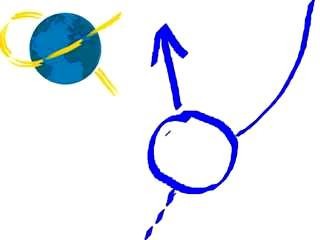
Impulse Editor
IMPULSE EDITOR is simple utility for defining the sequence of impulses applied on object in order to change its position and velocity at some particular moment in time.
Data is entered and displayed in SI units (second, kg, meter/second etc.). Velocity data is defined in (x,y,z) vector components in Cartesian coordinate system.
In order to use jet impulse program in Gravity Nu program file (*.JI) should be located in the same folder as the main project file and should have the exact same name as main project file (except extension).
Once existing program is opened or new program is started steps can be added, edited or deleted.
Selected program step data field can be edited by double click (mouse left button) on that field. On double click on the field, pop up dialog will be shown where data can be edited. When ENTER is pressed or SAVE button is selected data is accepted. If CANCEL is pressed or EXIT button is selected data edit is cancelled.
Saved program file can be opened (with linked project file) in Gravity Nu main software - this can done for every change made (all applications, Gravity Nu, Impulse Editor and Project Editor can be opened at the same time).
NOTES:
As an example, if one wants to launch spaceship from Earth at some particular moment of time:
NOTE !! :
!!! All above stuff is simple, the hard part is to figure out how to define correct impulse values at the correct time(s).
Data is entered and displayed in SI units (second, kg, meter/second etc.). Velocity data is defined in (x,y,z) vector components in Cartesian coordinate system.
In order to use jet impulse program in Gravity Nu program file (*.JI) should be located in the same folder as the main project file and should have the exact same name as main project file (except extension).
Once existing program is opened or new program is started steps can be added, edited or deleted.
Selected program step data field can be edited by double click (mouse left button) on that field. On double click on the field, pop up dialog will be shown where data can be edited. When ENTER is pressed or SAVE button is selected data is accepted. If CANCEL is pressed or EXIT button is selected data edit is cancelled.
Saved program file can be opened (with linked project file) in Gravity Nu main software - this can done for every change made (all applications, Gravity Nu, Impulse Editor and Project Editor can be opened at the same time).
NOTES:
- numbers are formatted in scientific notation (example : 1.123456123456E12) with 12 digit precision after decimal separator and variable type is FLOAT (EXT) with range of : +/- 4.19e-307 to 1.79e308
- UNITS for data are : velocity in m/s, mass in kg
- velocity data is defined as (x,y,z) vector components in Cartesian coordinate system.
- velocity of ejected mass is relative to object programmed
As an example, if one wants to launch spaceship from Earth at some particular moment of time:
- place the object at the position of the Earth plus radius of Earth (XYZ position component)
- copy the velocity components data from Earth to spaceship velocity data (at t=0)
- in order to create the most real situation, the spaceship could/should be placed some distance above the surface (to avoid atmosphere or any other drag force which is not included in calculation)
- define initial step (impulse at t=0)
- define as much steps as needed
NOTE !! :
- for real situation take rotation/tilt of Earth velocity component into account (for some actual position on Earth surface)
- impulse is defined with amount of ejected mass (jet stream or ejected particle) and velocity of ejected mass
- you can also program mass loss of object without impulse applied (if one wants to simply get rid of some part of spaceship) if velocity is set to zero
- velocity components of ejected particle or jet stream is defined - impulse on object itself is opposite
- sum of all program steps ‘ejected mass’ and has to be less then initial object mass
- intervals (when jet engine is ON) cannot overlap in time
!!! All above stuff is simple, the hard part is to figure out how to define correct impulse values at the correct time(s).
